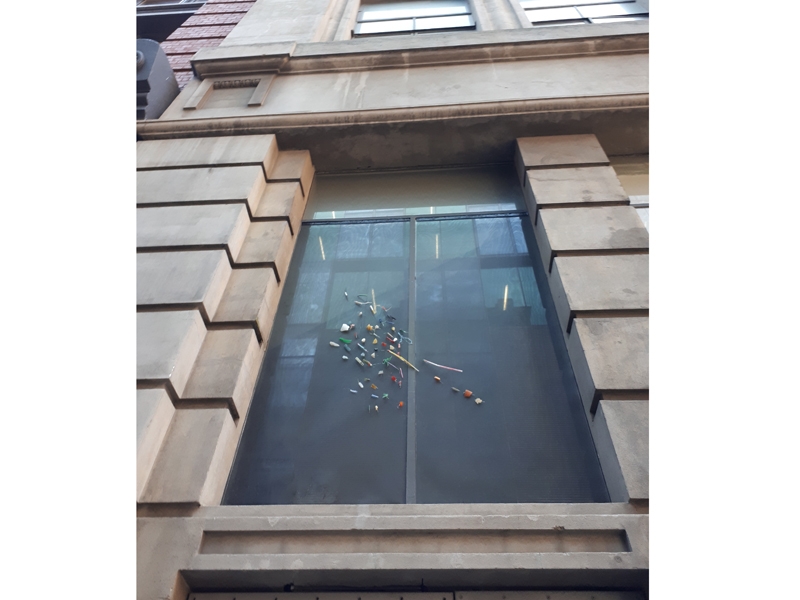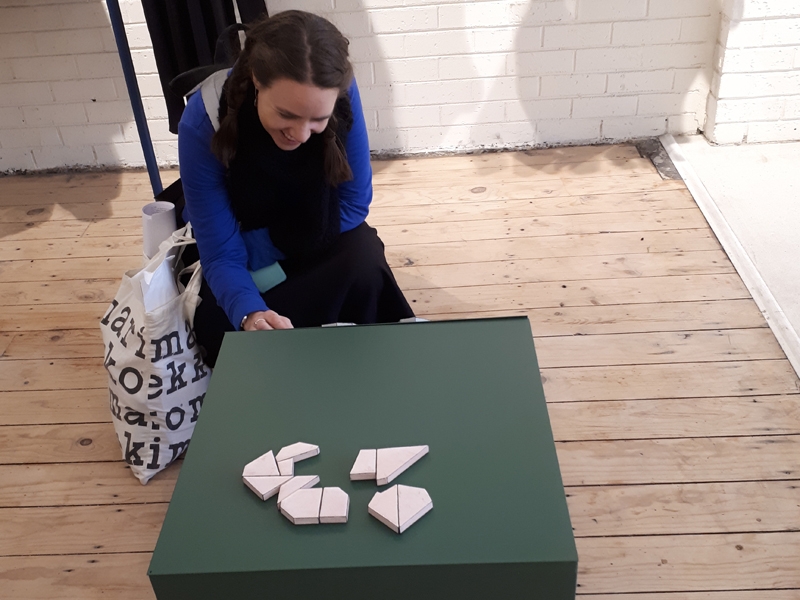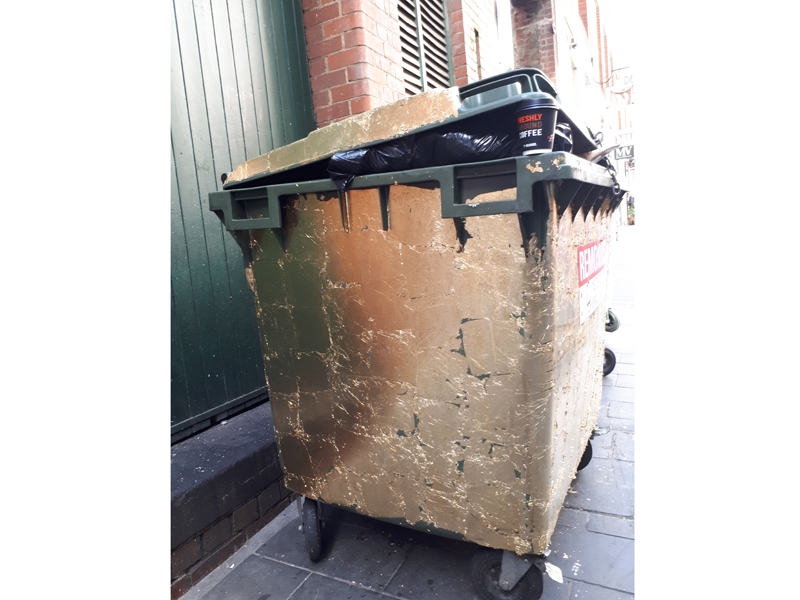The theme, direction, and format was entirely up to the writers, but the texts reflect on the event in some way—what they saw, issues that arose, discussions that were sparked, etc. This essay by Vidya Sai Rajan, an early-career writer, is the third of four and examines the curatorial decision of the event organizers to focus on playfulness and interactivity in the jewelry selected for inclusion in the fair.
Writing on Munich’s Schmuck in The Golden Standard of Schmuckashau, Liesbeth den Besten decried the trend in contemporary jewelry, exemplified by Schmuck, of pursuing “objecthood” at the expense of “jewelryness.” Den Besten considers that the current obsession with jewelry as aestheticized art object has the tendency to forget about people—“that humans like to wear jewelry,” that jewelry can “seduce.” She also locates certain curatorial gestures that support this trend—glass cases, art installations that overwhelm individual pieces, a lack of explanation and accessibility for the work, a distancing of audience—and strongly urges a move away from these choices.
The curators of Melbourne’s second Radiant Pavilion, labelled by some as the “Schmuck of the south,” appear to have taken up den Besten’s clarion call. The Pavilion returned this year after a two-year break, and the program as a whole functioned as something of a sprawling anthem to jewelryness. The programming of events like Anything Imagined Can Be Worn/How to Wear It!—where viewers were invited to try on jewelry in various configurations—or Different Tastes—where festival-goers were reminded of functional aspects of jewelryness by drinking from sake cups fashioned from silversmithing techniques—announced this intention. However, it was also discernible in the directness with which work in more “traditional” exhibitions were presented. Exhibits and events were spread across Melbourne’s central business district and several inner-city suburbs, and galleried aesthetics were minimal. Objects were rarely encased, often contextualized in relation to each other, and frequently located in communal or public spaces: bookstores, libraries, hotels, alleyways, and windowsills.

A sustained and welcome effort was also made to create discussion and exposition around the exhibitions. Over the week, there was a robust discursive component of panels and talks, workshops on making, new ways of generating discussion (Drinking with Jewellers, for instance), and a pleasing tendency for makers to be present around their work, ready to chat, provoke, or merely point elsewhere.
The effect of much of this was a program that moved away from the aesthetic markers of objecthood and to something closer to den Besten’s vision. This on its own could be viewed as an exciting contribution to the conversation around contemporary jewelry. However, I want to suggest that through much of the program, the curators and artists of Radiant Pavilion 2017 actually went further, and did so through the innovative decision to deploy what might be termed the principle of play.
The privileging of play as a curatorial investigation was evident in the programming of works like Jewellers Behaving Badly, in which jewelers passed a locket between them at various events, prompting observation and questioning; or in Liminal Intervention, in which pieces of magnetic jewelry were left in unexpected locations, waiting to be discovered. Play is ignited through surprise and the creation of chance encounters, which can be present in the simplest of decisions, like the choice to mount The Trees Have Names, an exhibition of jewelry inspired by the natural world, in a quasi-industrial alleyway, exposed to the elements.

It can also be sustained and expanded in more game inspired work such as Puzzle Time, which invited viewers to configure jigsaw-like abstract brooches into bigger shapes, and Labour Exchange, where participants could obtain a piece of jewelry through the barter of either cash or a more abstract proposition such as an experience, activity, or feeling—with a lack of thresholds as to a base-level offering. This freedom from constraints ironically created the pressure and liveliness of a game, as participants were activated to enter into real-time negotiations with the self, developing a hyper-awareness of their surroundings. The act of exchange—a common and core feature of games, and a pedestrian, necessary feature of a market—opened up to repurposing and amplification.

Play is found in other modes too. It often disarms by being wry and humorous. It thinks nothing, for instance, of draping an outsize crafted chain and collar on a solemn colonial-era statue (as in Susan Buchanan and Eli Giannini’s Urban-a-wearness). This is how it invites us in. It also loves the present moment, forcing us into the now by throwing our bodies into roving attention and action, like in the dazzling event Paved with Gold, which tempted pedestrians to follow glimpses of gold shavings through the cobbled city lane of Crossley Street, accumulating brooches if they were lucky, until both the lane and their vision were saturated with gold, culminating in the silly spectacle of a gold-covered trash can.

These works, underpinned by surprise, warmth, presentness, and audience involvement, roughly speak in the grammar of participatory art, a form often concerned with dislodging boundaries of self and other. This is a canny and novel approach to exploring the potential of jewelryness. Certainly, it fulfils den Besten’s injunction to attract the viewer, but we don’t find here an exact return to a conception of jewelry as adornment. It is people-focused, yes, but people are not the palette or the locus. Hierarchical relationships can underpin both the conception of jewelry as craft or wearable, and jewelry as aesthetic object. In the former, jewelry becomes something circumscribed by human desire and functionality; in the latter—which has been viewed as a reaction to the former—it transcends human need and is unto itself. When jewelry or ideas around jewelry are encountered through the prism of play and participation, though, the relationship is different: Both parties are animated, they’re something like equals—and the result can be conversation and possibility.
This came explicitly into being in works like the previously mentioned Labour Exchange, or in events like Voveo, in which participants could choose certain promises and then pledge them on a wall of Post-Its in exchange for a talisman pendant. These projects required participants to function within a kind of game. They were thus prompted to look and listen to objects, and consider not just what they might mean at first glance but the multitude of possible, often personal, meanings and values we can ascribe to them. In both projects, tangible offerings such as “dinner with my family” and abstractions such as “a promise to humility” were common. I observed participants relaxed and lively in the play of each event, often negotiating with themselves and the objects—either changing their offering, or particularizing it. There was acknowledgment of the attraction of the jewel as something of beauty to be worn but equally a wrestling with it as a material object that could refract symbolically into social and individual meanings. Although it’s not necessarily the soundest of metrics, I think it no coincidence that these projects generated the most Instagram noise (judging by the number of tags) from participants and community.
Other possibilities arose in works like Puzzle Time, where I observed people consistently energized in the act of creating abstract shapes from freeform magnetic puzzle pieces. At first, there was often a rush to connect the pieces, then, slowly, an awareness of the textures and the integrity of the shapes. People grew selective about their making, judged what final form made sense to them, and opened up to the intriguing potential and sensation of being both maker and consumer.
Most absorbing for me, though, was the ambitious Crossley Street project, Paved with Gold. There were several elements to this work, many of them performative, yet one of its most engaging aspects arose away from the alley itself. As I walked about the city, I met people who had on them a similar trace of gold. This was frequently in the form of a brooch they’d picked up from a hidden corner of the laneway, but also manifested as bits of gold leaf on their clothes or shoes—the latter the result, I was told, of a pop-up shoe-shine service offered by an occasionally appearing roving performer.

The sense of surprise, the call to attention and visceral searching enlivened by the installation, had thus replicated itself in the wider world. To see people walking in the city, marked as different because of the trace of jewelry, creates an affective response but also a critical one. Gold is historied in Victoria. It drove progress, it marked wealth and class, it caused migration and the movement of hungry, desperate bodies. Back in the alleyway, playing at discovery, my companion and I had unwittingly enacted a scavenging. Now, in the grayness of the city, we saw other bodies had done the same—and we were joined in a fraternity of sorts. We can read into this the possibilities of joy: we are those who have appreciated something beautiful, the crafty brooch a symbolic aspiration for better things. Or, depending on our contextual understanding, we are those marked by greed and difference, the gold’s flimsy glint taunting us as “not real gold”; the gold-leafed trash can acquiring perhaps a grimmer meaning.

In either case, like much participatory art and work that relies on play, we’re left with fruitful conversation and questions about our ethical and personal relationships with other players. In this instance, that category included both people and, in a highly successful curatorial move for Radiant Pavilion, jewelry itself.




